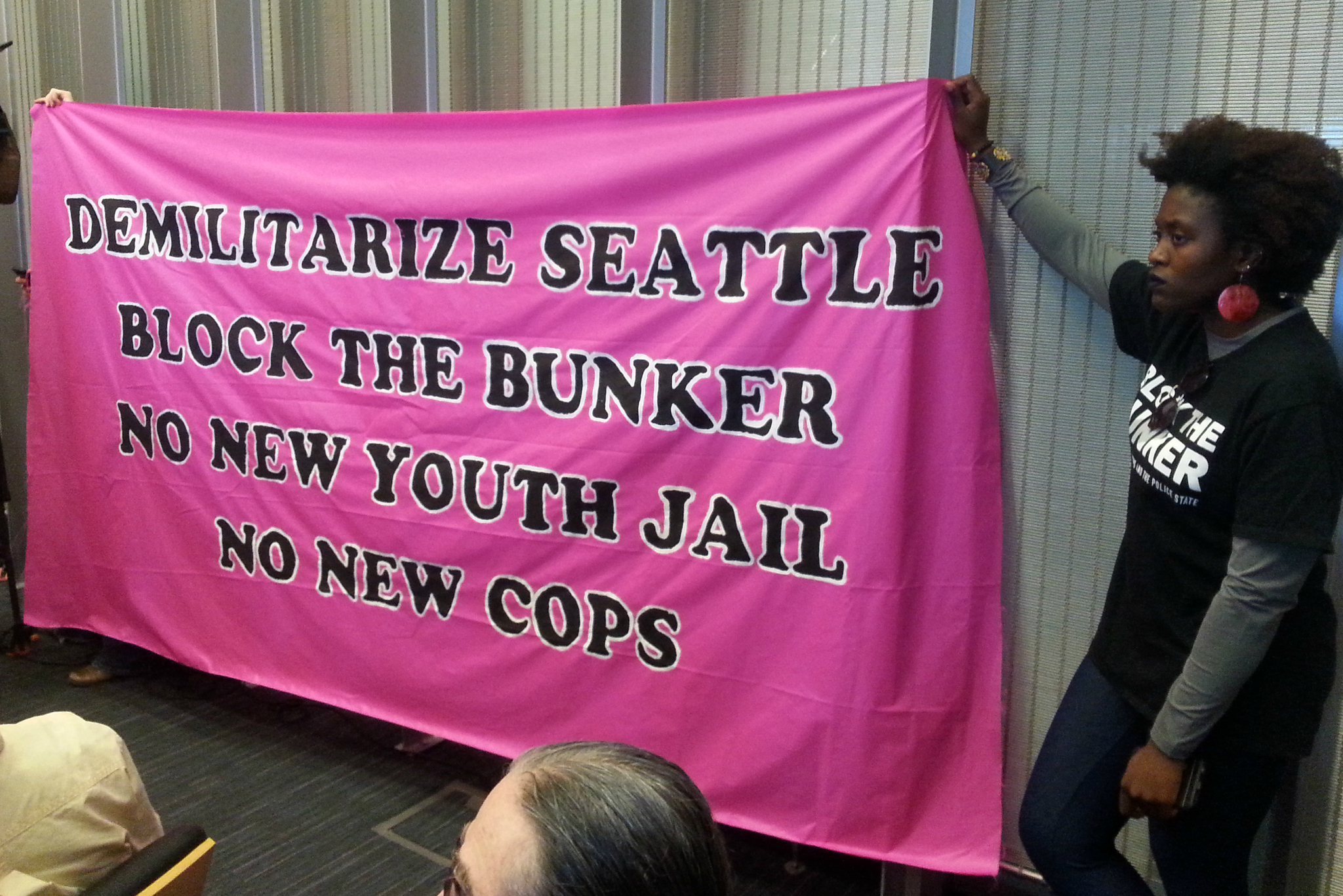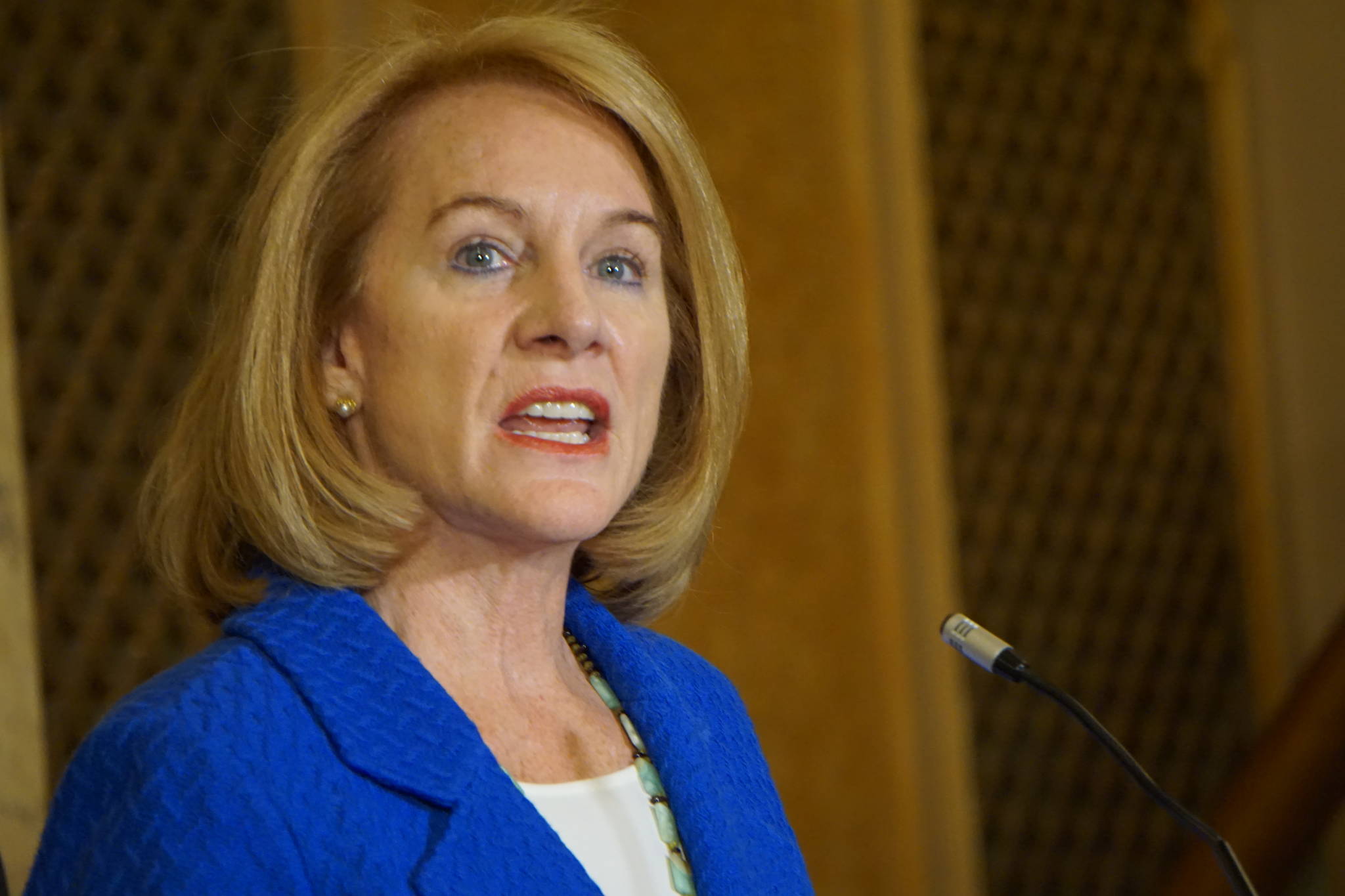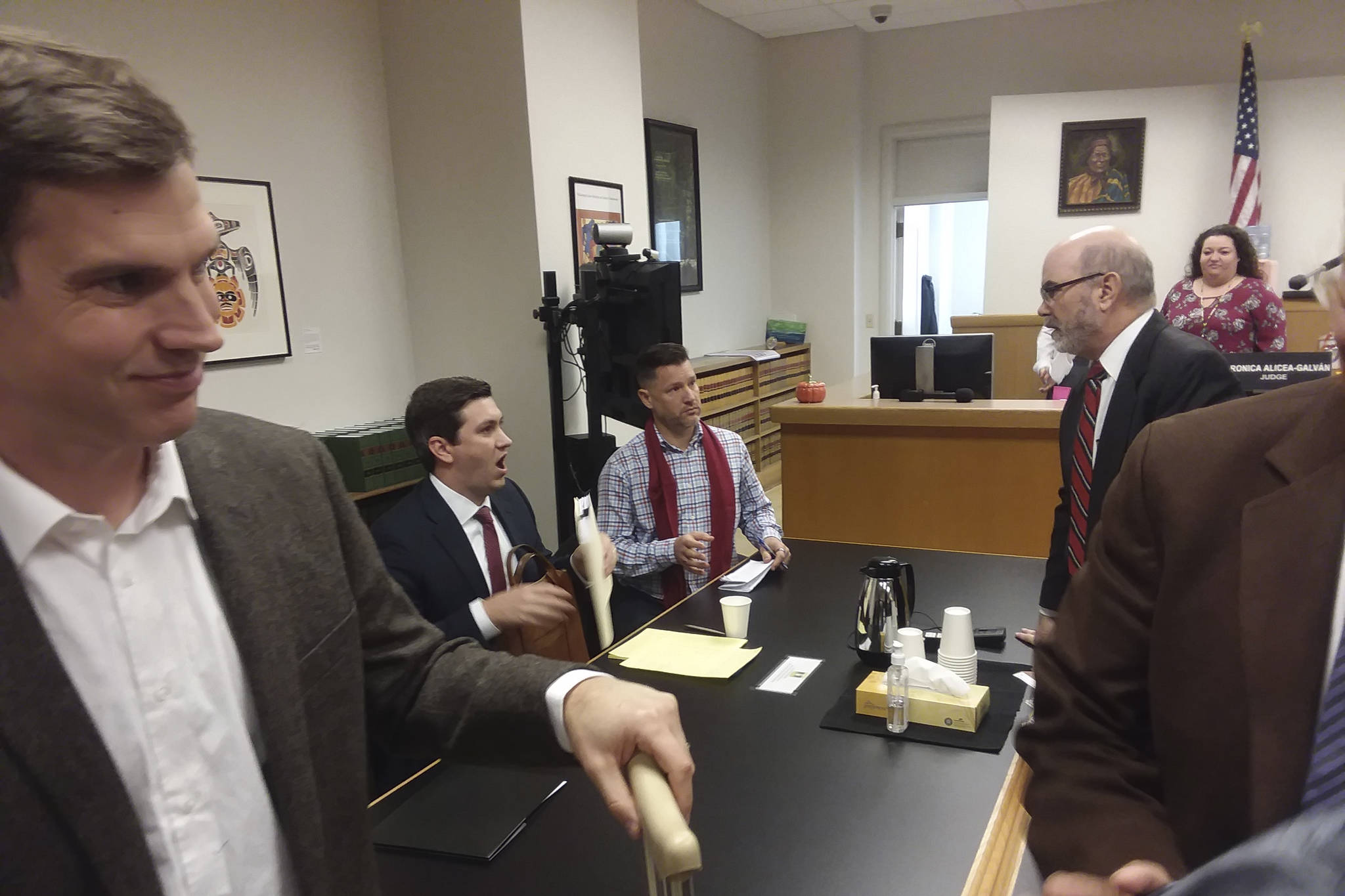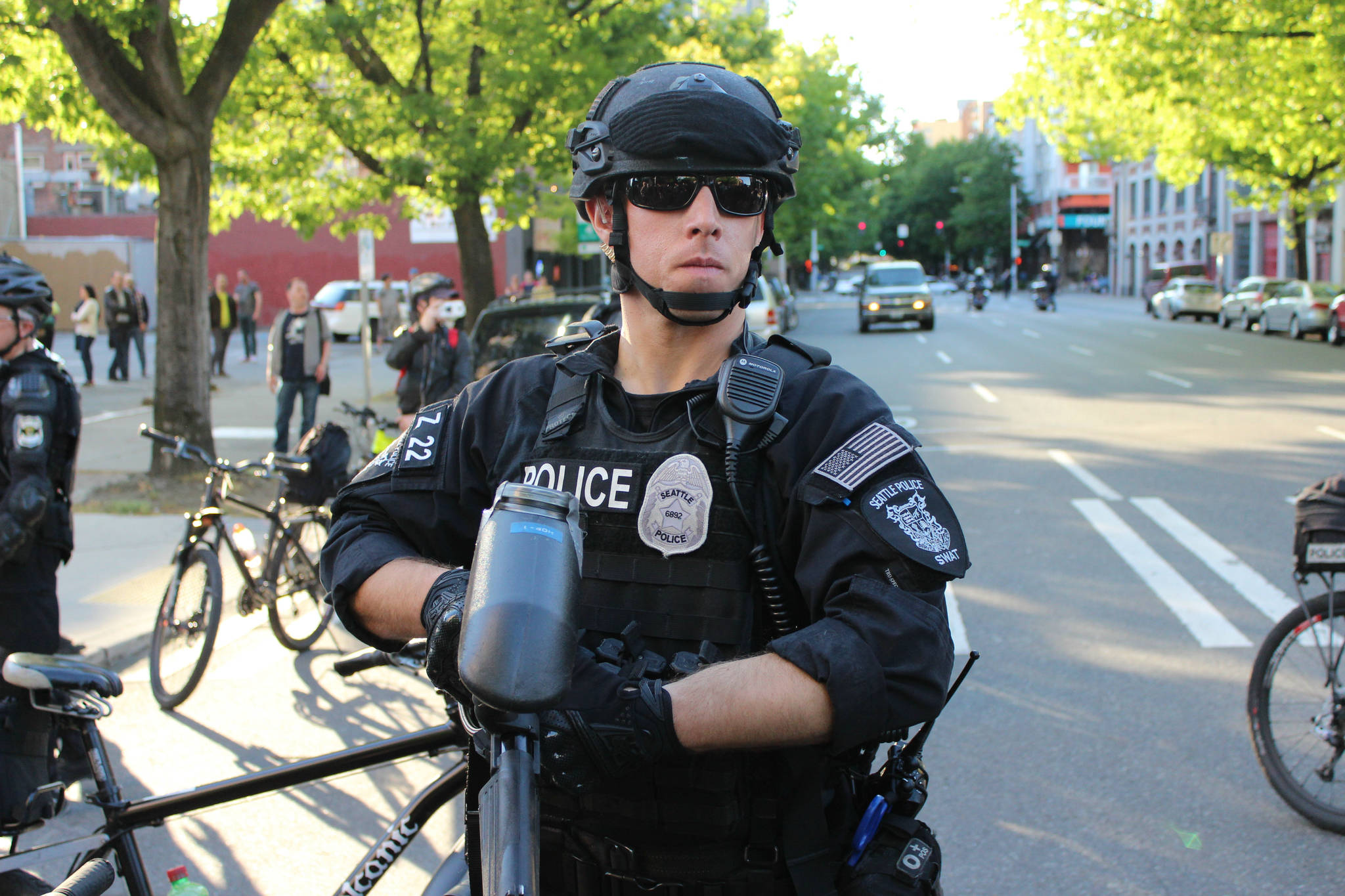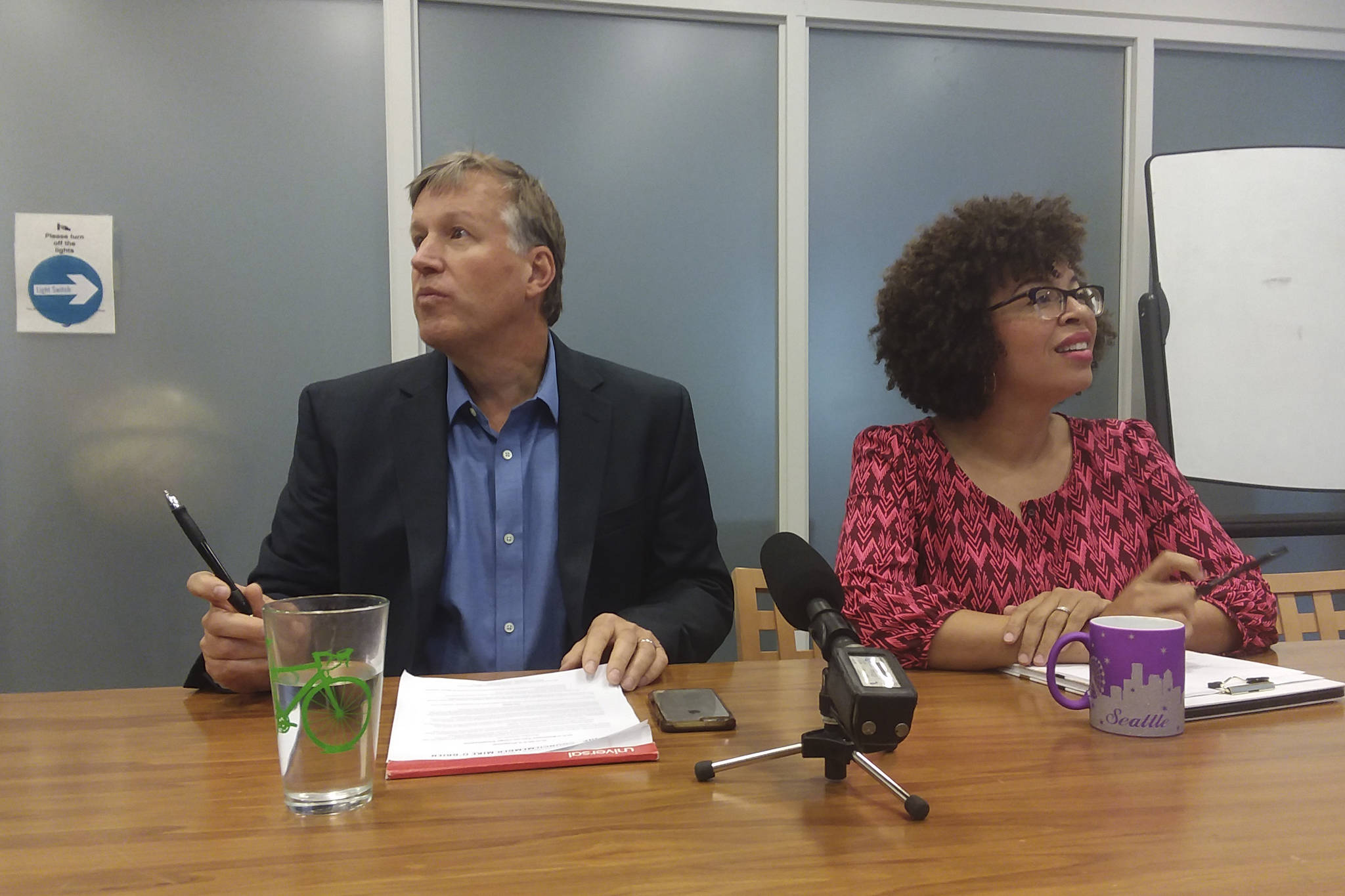Not long after Seattle City Council voted unanimously to pass secure scheduling legislation Monday afternoon, black lives activists interrupted the council meeting with demands for reductions in police and prisons. In response, council president Bruce Harrell adjourned the meeting. The following two hours consisted of an unprecedented public conversation between activists and a handful of councilmembers about problems with, and alternatives to, police.
During public comment at the beginning of the meeting, Harrell called up to the podium activists with the #BlockTheBunker movement who’d signed up together for public comment. (The “bunker” is a proposed, unprecedentedly expensive new police station in North Seattle, the construction of which these same activists recently pressured the mayor and city council to indefinitely delay.) They theatrically obliged: six black activists wore chains and tape over their mouths, some in orange prison jumpsuits, while four white activists escorted them wearing police costumes and pig noses.
“Let’s go! Convicts coming through!” the guards yelled. “You’ve got two minutes!”
The commenters spoke to the council and their peers of the abuses they’d suffered at the hands of the police state and the prison-industrial complex. “My first interaction with the police was when I was 10 years old,” said Bipolar, one of the chained activists. “They slammed my head against a trunk, and pulled their pistols on other 8-to-12 year olds who protested the way they treated me. ” Another activist, clad in an orange jumpsuit, criticized the use of domestic and sexual assault as a justification for expanding policing. “I want to shut that down right now,” she said. “Women and young girls of color are threatened by the police, regularly. I cannot call the police and feel safe.”
The same activist also chastised the council for not doing anything to prevent the county from building the proposed Children and Family Justice Center, which includes a jail for juveniles. “To have a youth jail when you say you want zero detention in this city is contradictory as fuck.”
"Building a youth jail when you have a goal of zero youth incarceration is contradictory AS FUCK" TRUE AF
— Seattlish (@seattlish) September 19, 2016
The performance ended with an evacuation. “The jail is on fire!” shouted one of the guards. “Everybody evacuate! Run, now!” In the audience activists held up fake flames made of paper, and the chained prisoners at the front of the the seating shouted “Wait! What about us?” as the guards ran away from the fire.
This performance wasn’t just a metaphor. #BlockTheBunker activists say that last week, youth prisoners were abandoned to their fates during an actual fire at the county Juvenile Detention Center. Seattle Fire Department records show that there was indeed a fire response at the youth jail last week—one big enough to merit two trucks and a chief. King 5’s Doug Dillon tweeted a picture:
Some type of fire call out inside the King County Juvenile Court on 12th pic.twitter.com/yH0waSazTA
— Doug Dillon (@dougdKING5) September 15, 2016
Crosscut’s David Kroman reports that in a statement, a King County youth detention facility spokesperson said, “A fire that was quickly extinguished started in a non-detention area of the Youth Services Center last Thursday just before 10 a.m. Because the detention area is securely separated off, staff and youth in that part of the building were not affected and were not evacuated. The smoke affected some of the administrative offices in other parts of the center and those areas were evacuated so that firefighters could make sure the air quality was safe. The affected areas were cleared by 11 a.m.”
After the performance, things simmered down for a little while. Harrell eventually cut off public comment despite still having four pages’ worth of people waiting to testify. He promised to allow more time for public comment after the meeting’s agenda was concluded. With much fanfare and mutual congratulation, the council proceeded to unanimously pass a secure scheduling bill that we’ve written about previously.
Seven minutes passed. And then things escalated.
It began as a clerk was reading out agenda item number six, a bill to rezone the maximum height in two areas “from neighborhood commercial two dash 40 with a pedestrian designation to neighborhood two dash 65—”
“If we’re not heard, we’ll shut it down!” cried someone in the audience.
“IF WE’RE NOT HEARD WE’LL SHUT IT DOWN!” roared the crowd of activists in response. The call-and-response protest chants continued, later turning into “What do the people want?” “WE WANT PUBLIC COMMENT!” and eventually the names of people killed by police followed “SAY THEIR NAME!”
“You’re giving me no choice but to adjourn the meeting,” Harrell said. The council quickly voted affirmatively, and most of its members walked out, though Harrell invited the activists to remain (rather than security locking the chambers to the public, which is standard when meetings aren’t in session). The formal council meeting was over. But the public debate, and a temporary transformation of the typically bureaucratic council chamber into a modern day agora, had just begun. Dozens of activists, many wearing black t-shirts with “Block the Bunker” written on the front, remained in the chamber for more than two hours. Someone produced a bullhorn, and the protesters addressed the remaining councilmembers (Kshama Sawant and Mike O’Brien, with Harrell there part of the time and Lisa Herbold making a brief appearance) and each other about the harms caused by police and prisons, what alternative public safety models could look like, and what the precise nature is of the conflict between black lives activists and the city council.
Local rapper Jamil Suleman, dressed up like Jesus Christ for comic effect, warned the council that despite containing nominal Christians, the city’s leadership has spent too much energy serving Mammon.
"I am all about helping homeless folks, feeding people, housing" -Jesus to @SeattleCouncil
— Casey Jaywork (@CaseyJaywork) September 19, 2016
If council doesn't get its act together, armageddon. "If you guys think my dad gets pissed, wait until you meet my mom."-Jesus
— Casey Jaywork (@CaseyJaywork) September 19, 2016
“You tell us to come with respectability politics,” said Tracy Stewart of the Buddhist Peace Fellowship, referring to the political strategy of asking nicely for change, “but when we do, you don’t listen…My style isn’t to yell and scream. I shouldn’t have to yell and scream to be heard.”
"Walking out–that's your guerrilla theater, is the council walking out." -Tracy Stewart
— Casey Jaywork (@CaseyJaywork) September 19, 2016
Harrell, before leaving around 5 p.m., responded to activists by pointing out that one of their demands—no new youth jail—pertains to a county project over which the city has little authority. “I hope you are putting this kind of pressure” on the county council, he said. On the other hand, he said, “They haven’t broken ground yet. You are being effective.” Harrell also said that he and other councilmembers have asked the law department to look into legal ways to block the youth jail, since the city could potentially get sued if it denies building permits for the wrong reasons. He suggested that a Race and Equity Toolkit Analysis might work, if it shows that the youth jail would have racist effects.
When Harrell asked what specific investment and policy decisions the activists wanted to see, organizer Nikkita Oliver (among others) replied that the city should divest from policing and prisons and invest in affordable housing and social services. “The solutions are right here,” she said: “resources that our community community centers need in order to work with the young people who are trapped in the school-to-prison pipeline.”
Oliver pointed out that as unpleasant as activists’ confrontational tactics may be to council, they represent deep political engagement by direct stakeholders on a pivotal issue. “What’s happening right now,” she told Harrell, referring to dialogue between him and activists, “is the more productive than what I’ve ever seen, but it literally wouldn’t have happend if these folks hadn’t disrupted council meeting after council meeting.”
Monday’s council meeting agenda did not include anything to do with police or jails; the activists’ apparent goal was to demonstrate that they are not satisfied with the mayor and council’s recent capitulation of putting the north precinct project indefinitely on hold. The real decision point on the north precinct is the city budget process, which will dominate the council’s time during October and November. There, they’ll mark their priorities with dollar signs, and be judged accordingly.
